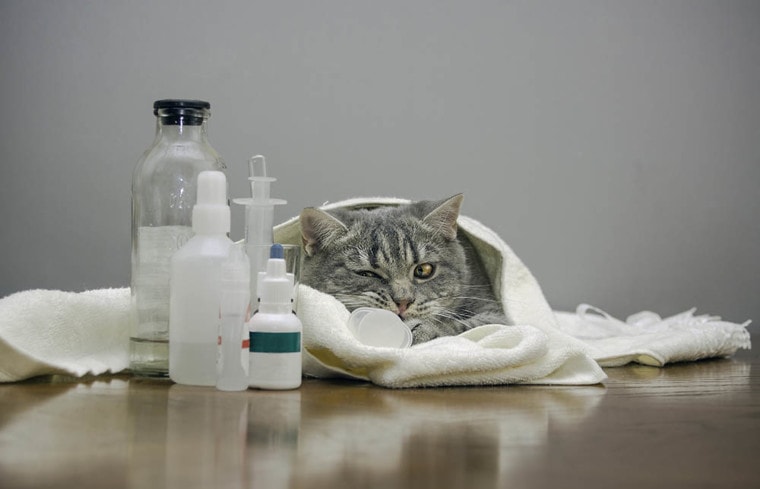
Click to Skip Ahead
Colds are no fun for anyone, and it can be surprising to realize that your cat can catch them too. Feline upper respiratory infections are similar to the human common cold, with many of the same signs. While sometimes the infections are only a passing nuisance, there are occasions when your cat’s cold can be more serious.
When your cat starts sneezing and suffering from a runny nose, it can be easy to panic about what’s wrong with them. We put together this guide to help you learn more about cat colds and to know when you need to visit a veterinarian.
However, if your cat is lethargic, not eating, sneezing frequently, or has nasal discharge or any breathing difficulty, they need to see the vet urgently. Please never give your cat any human cold medicines, as they contain harmful and toxic substances for cats and may be lethal in some cases.
Signs of Feline Upper Respiratory Infections
Feline upper respiratory infections affect your cat’s throat, nose, and sinuses and have many of the same signs that you’ll recognize from your own colds. Not all cats will experience all these signs, though, and they may take a few days to appear. Some cats may also develop conjunctivitis, while certain viruses can lead to mouth ulcers. Upper respiratory infections can progress to pneumonia in some cases if left untreated. It’s good to know what to look out for, so you can help your feline best friend feel better:
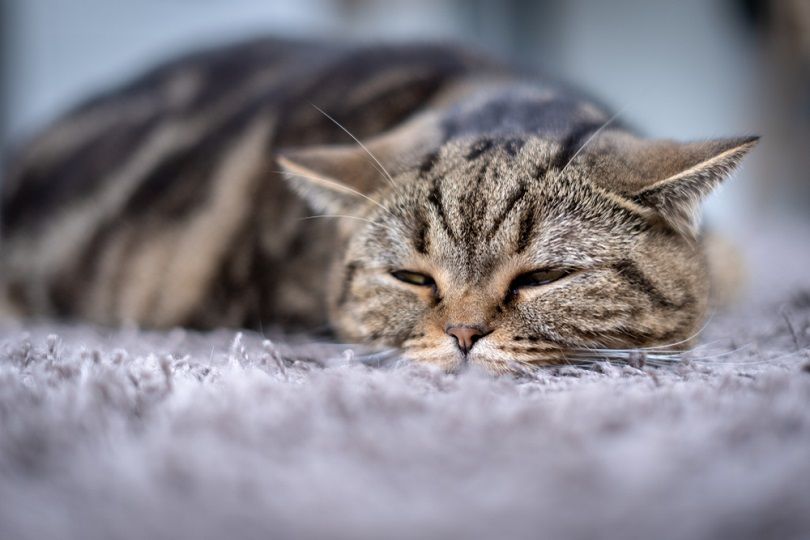
What Causes Cat Colds?
Your cat’s upper respiratory infection can be caused by viruses or bacteria and is often spread the same way that human colds are: through droplets from sneezes by other cold-suffering cats. A small percentage of cats will carry the viruses for the rest of their life without necessarily showing signs of illness, but they may act as a source of infection for other cats they come in contact with. When they are stressed or develop another illness, the virus may reactivate, causing upper respiratory signs again.
Unsurprisingly, outdoor cats are more susceptible to catching a cold than your indoor feline. Outdoorsy cats have a greater chance of meeting fellow adventurous kitties when they’re not under your watchful eye. Similarly, your cat can catch a cold from fellow felines in a cattery if you boarded them while you were on vacation or a business trip.
Cats can spread colds just as easily as humans can. Here are a few common viral, bacterial, and fungal illnesses that our feline friends can pass to each other:
Speak to your vet about ways to reduce your cat’s chances of getting infected with some of these common pathogens based on their lifestyle, as well as through neutering and vaccinating your cat regularly.
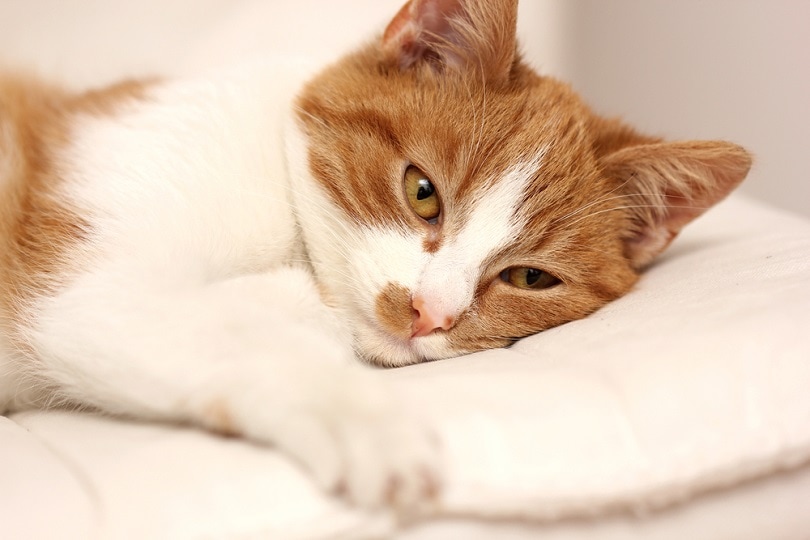
Can a Human Catch a Cold From a Cat?
While your cat sneezes and sniffles as they suffer from their cold, you may wonder whether humans can catch the same pathogens they have. Fortunately for us humans, your cat’s upper respiratory infection is usually only contagious to other felines and rarely poses a risk to humans.
However, there is a very small possibility of Bordetella bronchiseptica and Chlamidophyla felis causing an illness in immunocompromised individuals, leading to a runny nose and mild conjunctivitis. If anyone in your home is immunosuppressed or you have very young children, it would be best to keep them away from the cat until they recover from their cold. If you have any health concerns, please speak to your doctor
If you have multiple cats and don’t want to spread the germs around, though, it’s a good idea to keep your felines separated until your sick kitty is feeling better. Wash your hands and change clothes after you interact with your sick cat too, as this will help you limit how many sick kitty germs make it to your healthy felines.
How to Care for Your Sick Feline
No matter who you are — feline, canine, or human — colds have a way of sapping away your energy and leaving you feeling uncomfortably miserable. Your cat might not be able to whine about how they’re feeling, but they can certainly make their discomfort known, and we can’t even give them a bowl of ice cream to perk up their day.
Fortunately, there are plenty of other, feline-friendly ways that we can make their colds a little less horrible. But first, if your cat is not feeling well, is refusing food, sneezing a lot, having nasal or ocular discharge, and having any breathing difficulties, they need to see your vet urgently. Nasal discharge can easily block off your cat’s nostrils, making it very hard for them to breathe, and this can lead to sudden respiratory collapse. They also won’t be able to smell their food as well, reducing their appetite significantly. If a cat has not eaten within 24 hours, they need to be checked by a vet due to health complications that may arise from them not eating.
Do note, however, that you should never give human cold remedies to your cat. They usually contain harmful and even toxic substances for cats, such as paracetamol, that is lethal for cats if ingested.
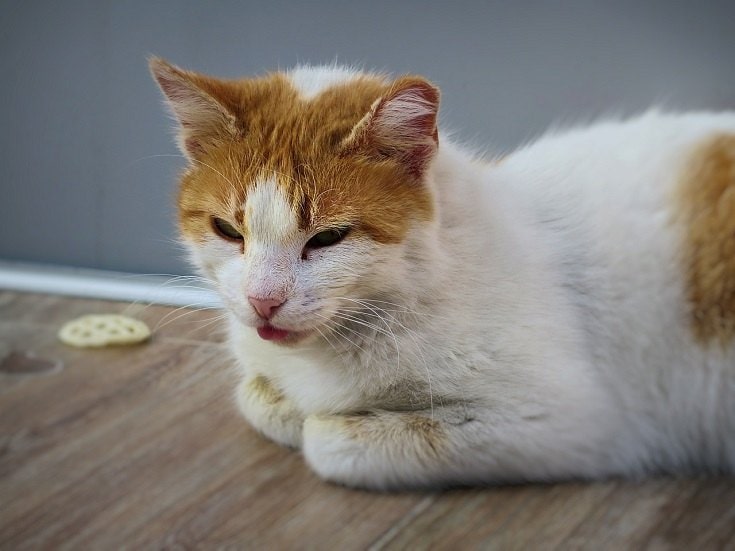
1. Humidifier
You’ve probably experienced enough colds to know how much they dry out your throat and nose. There’s only so much water that you can drink before you start feeling uncomfortably bloated or constantly dragging your weary limbs to the bathroom.
Setting up a humidifier may help your cat by increasing the level of humidity in your house. Your cat will breathe in the damp air, and it’ll soothe their dry nose and throat.
2. Warm Wet Food
Convincing your cat to eat something can be challenging, and it’s easy to see why. Eating cold, dry kibble with an already dry throat sounds unpleasant, and we don’t even have to experience it. If your cat is refusing to eat anything, try wet food instead of their usual kibble. The moisture will help keep them hydrated and is often more palatable.
You can also warm it up a little so the scent is more likely to reach through your feline’s blocked nose and be more enticing to your cat. But if your cat is refusing food for 24 hours, that’s a red flag and a sign that they need to see the vet. Otherwise, they are at risk of dehydration and health complications from not eating.

3. Damp Cloth
Another familiar sign that sick cats can suffer from is the dreaded runny nose and eyes. To keep your cat as comfortable as possible, use a clean, damp cloth or cotton wool to mop away any nasal discharge. You can also use saline solution and gauze pads to cleanse irritated eyes. Remember to do so gently, and expect your cat to dislike your attempts.
Keep a close eye on the color and texture of the discharge from your feline’s eyes and nose. You may notice your cat having irritated eyes along with clear discharge and squinting frequently. Thick, yellow, or green discharge is also common. The same goes for the nasal discharge, which, in some cases, can even be bloody. Take your cat to the vet if they are squinting and have ocular and/or nasal discharge that isn’t clear and is blocking their nose, as this may cause significant respiratory distress.
4. Pamper Them With Extra Care and Attention
One of the best ways that humans make themselves feel better when sick is by doubling up on blankets. Your cat can benefit from a little spoiling in this way too. Fluffing up their favorite pillow or bundling extra blankets into their chosen napping spot is a great way to make sure they’re comfortable without crowding them. This will also help them stay warm, but let them choose where they want to sleep, as they may prefer the cold floor if they have a fever. Make sure they are not disturbed by other pets, children, or house guests. Ensure they have plenty of tasty food, fresh water, a clean litter box, and a cozy spot nearby, as they may need to rest more than usual. However, monitor their appetite and activity levels closely, and if they are lethargic, constantly sleeping, not wanting to move, not eating, or struggling to breathe, they should be seen by your vet urgently.
When to Visit a Veterinarian
Most colds, even for our feline friends, only last a few days. In most cases, your cat will be back to normal and getting up to their usual mischief in no time at all. If your cat is still suffering from their cold at the end of the week, though, it’s time to consider a visit to your veterinarian.
Even cat colds have the potential to cause more serious health issues, such as pneumonia, and a lingering illness can leave your cat vulnerable. Pay particular attention to your cat’s breathing and how much they eat, if at all. If they are struggling to breathe or breathing heavily due to nasal congestion and discharge or haven’t eaten anything within 24 hours despite your best efforts, visit your veterinarian urgently. A blocked nose in a cat can lead to severe respiratory difficulty and is a genuine emergency.
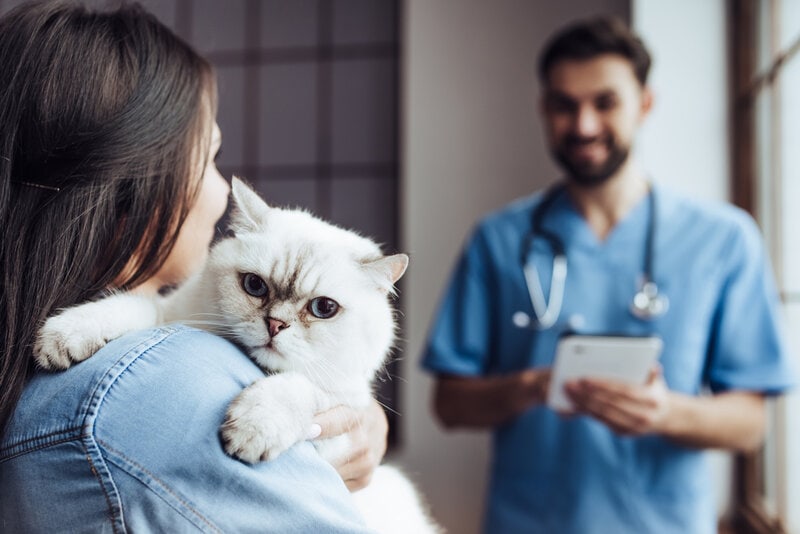
Final Thoughts
Cats can catch colds, referred to as feline upper respiratory infections, just like we can. They can spread their cold to other felines too. Fortunately for us cat owners, we’re usually immune to cat colds, as most of these pathogens are species specific, which makes us excellent choices for nursing our ailing kitties back to full health.
Outdoor exploration or recent visits to a cattery are both ways for your cat to catch colds from other felines.
Help your cat stay warm and comfortable by setting up a humidifier and tempting them with some tasty and warm wet food. Also, remember to keep an eye on how long your cat’s signs last, along with their severity. While most cat colds pass in a few days, some can lead to serious complications and require veterinary treatment. Never give your cat any human cold medicines, as these are often toxic to cats, and some ingredients may even cause fatal outcomes. If your cat is refusing food, not wanting to move, having nasal discharge, or struggling to breathe properly, they need to see a vet urgently.
See also:
Featured Image Credit: Anna Nikonorova, Shutterstock








